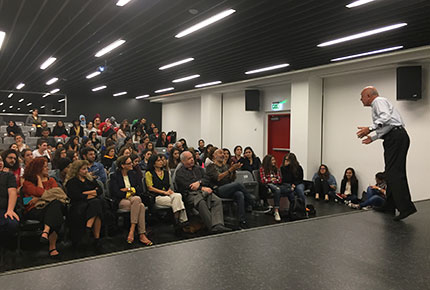The evolutionary process of art is now complete, says Cesar Nammour
Prominent Lebanese art historian discusses the history of art at LAU.
The history of art is over, its journey complete. So said Lebanese art historian Cesar Nammour yesterday to an auditorium overflowing with students from LAU’s Fine Arts and Foundation Studies program, walking his audience through the theory supporting this radical idea.
“The linear history of art as witnessed since the Renaissance has come to an end. It has been replaced by pluralism, in which all can or has the potential to be art,” said Nammour, referring to Authur Danto, who “wrote most clearly the obituary of art.”
In his presentation, Nammour also referenced American historian Francis Fukuyama, and German philosophers Friedrich Nietzsche, Martin Heidegger and Georg Hegel. “Fukuyama saw the collapse of the Berlin Wall as the end of history, regarding history as an evolutionary process that took its final form in liberal democracy, from which we cannot progress further,” he explained. “Similarly, art has arrived at pluralism where complete freedom reigns and rules no longer bind us to a definition of art.”
Displaying a photograph of the “Fountain” — a famous 1917 work by artist Marcel Duchamp, which consists of a signed image of a urinal —Nammour asked, “Is this art?” and launched into the criteria behind various theories that define art. “I tend to be a formalist and believe that the aesthetic is of great importance when defining art,” he shared. “But with the rise of contemporary art, the institutional theory prevails, which gives the ‘art world’ and its various players — including curators and critics — the authority to bestow upon any piece the status of candidate for appreciation.”
Nammour co-owns the MACAM gallery in Jbeil and notes that the contemporary works on display on its walls are more popular with the public than the modern pieces. Historical theorists would argue that all newly-produced art must bear a relation to existing works; simultaneously, cluster theorists argue that the ready-made cannot meet the attributes of art. However, contemporary art has broken through all boundaries, prioritizing concept and self-expression over execution and the aesthetic, and involving the audience as much if not more than the artist.
The historian’s brief presentation was followed by a long and lively discussion that saw most stay long after the official time allotted the lecture ended. Though he had explained the evolution of art through various eras — imitation, ideology, aesthetic, post-art and post history — some in the audience were uncomfortable with the notion that art history was over, arguing that technology had simply spurred a new movement, comparable to impressionism or surrealism.
Nammour was, however, steadfast in his belief that no more movements will be witnessed and that we now live in an era where the homogenization of culture, photography, the internet and global travel have all contributed to the globalization of art, which is now an anarchic mix of media, ideas, materials and technology. “Art has reached its end, not by being abolished but by being dissolved into everything else,” he asserted.
More
Latest Stories
- Bolstering Cancer Care Through Psychology at LAU
- Alumni Solidarity and Support Dinner in London Gives Hope to LAU and Lebanon
- The LAU Genetics Team on a Discovery Streak
- In Loving Memory of LAU Student Mohamad Nasrallah
- Alumnus Hussein Freijeh: From Local to Global and the Lessons Learned in Between
- LAU’s Research Excellence Shines: 25 Faculty Members Ranked Among World’s Top Scientists
- How Can I Be Happy in These Trying Times?
- Engineering Students’ Projects Secure Funding at the National Level


